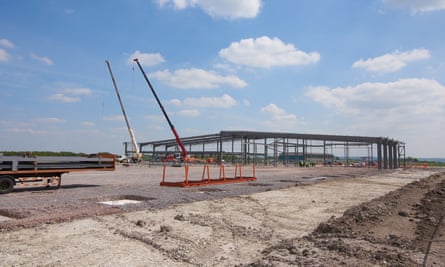A site under development by the Science Museum will give the public a chance to see hundreds of thousands of items that have been in storage for decades.
Among highlights is a 1947 passenger aircraft that was used as an Australia and Asia tour plane by the Rolling Stones in 1973 and a year later was transporting cattle to Libya.
There will also be a column from Europe’s first reinforced concrete building, a TV detector van, the world’s first amphibious hovercraft, Apollo mission patches, the best microscope collection in the UK, the first examples of plastic, century-old electric vehicles and the type of Remington electric shaver that in 1978 impressed Victor Kiam so much he bought the company.
The Science Museum Group, which has outposts in London, Manchester, Bradford, York and County Durham, on Thursday outlined its plans to move more than 300,000 dizzyingly diverse objects from its stores in west London to a new and truly vast site near Swindon in Wiltshire. It will use £40m it has been given by the government to develop a 220 hectare (545 acre) former RAF base it has owned since 1979.

The centrepiece will be a new building that will be 300 metres long and 90 metres wide, enough to contain 600 doubledecker buses.
“We refer to them because we do have actual doubledecker buses,” said the Science Museum Group’s managing director, Jonathan Newby. “Not 600, I don’t think, but we do have them as well as tractors, printing presses, medical equipment, bicycles and every aspect of innovation and engineering developed over the last 200 years.”
Newby said the project was about more than storage. There would be conservation labs, research facilities and far better public access to its stores. “It will set new standards for collection care.”

The museum, along with the V&A and the British Museum, is having to move out of Blythe House, originally the headquarters of the Post Office Savings Bank, in west London.
While the V&A is planning architecturally innovative stores in east London with dramatic 360-degree viewing spaces, the Science Museum is prioritising functionality. But they still hope to give visitors a wow factor when they enter.
“You know that scene in Raiders of the Lost Ark with the warehouse,” said Karen Livingstone, director of masterplan and estate. “We want that sort of exciting experience.”

The job of going through and assessing the collection before the move has already started. This week a team of about 50 people had reached about 140,000 objects.
“Interestingly, we are unearthing things that we really didn’t know that we had,” said Newby. “Our collections are so vast that we are forever finding things that might not have been looked at for over 50 or 60 years.”
The new discoveries include important notebooks that once belonged to engineer James Watt and objects that belonged to the chemist and dye pioneer Frances Micklethwait. “Her work now is going to be greater appreciated because of the work we have been doing at Blythe House in understanding our collections.”
The plan is for construction to be completed in spring 2020. Moving objects is due to take two years and the site should be finished by 2023.
To mark the beginning of construction, the museum announced a £70,000 art commission seeking creative responses to the new facility. It said community participation should be at the heart of applications.
